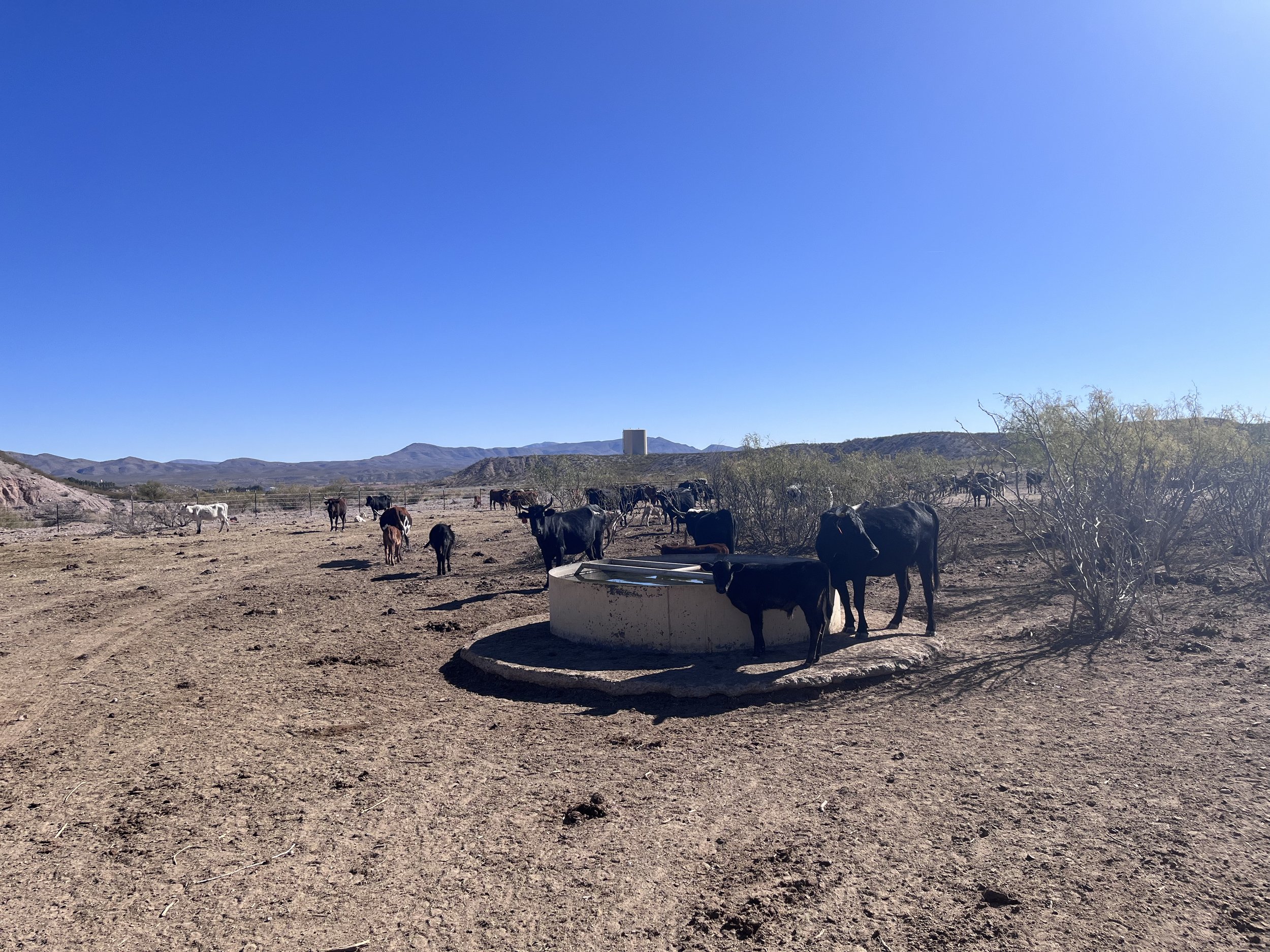Using Adaptive Grazing on Grasslands to Hold Soil Moisture
Grasslands, Grazing, and Water Harvesting
Water powers adaptive grazing, but not always in the ways you might expect. Cattle need 7-20 gallons of water each day to thrive, but water access alone is only part of the equation.
Grazing success depends on unlocking the landscape's innate potential to slow, spread, and store seasonal rainfall, thereby extending the growing season.
Broadly, there are two types of water required on a grazing operation: water for livestock and natural rainfall or riparian waters that hydrate the land and can remain in the landscape. Once activated, grasslands act like a sponge, soaking up moisture—much of which falls intermittently with droughts punctuated by extreme deluges. Irrigation provides a middle ground, where riparian waters and aquifers are tapped to support grazing operations.
Pasture and rangeland are often found in areas with between 10 and 33 inches of annual rainfall. This creates a tension, as many of America’s grazing acres lie in regions where rainfall falls below optimal levels reducing the ability to stock livestock. As rainfall decreases, the challenge of maintaining sufficient soil moisture for successful grazing becomes increasingly precarious.
Corriente Cattle in a New Mexico Holding pen illustrate how erosion can follow narrow drinking access points.
Ranch Management Tools
Cattle and other livestock cannot graze pastures without water—and though they can walk up to a mile to access it, less is more.
To ensure grazing is evenly distributed, water can be curated in ponds, pumped to tanks, or drawn from wells, making water accessible across the landscape. Effective water distribution is a key first step toward adaptive grazing, the focus of Kateri’s Carbon Grazing programs.
Longer drinking troughs, which allow better access for livestock, are also highly desirable. Too few or poorly placed water sources can cause cattle to congregate around water points, leading to overgrazed areas and compacted soil. Remote management systems, such as Ranchbot or Ranchsense, allow producers to monitor and control water systems remotely, influencing cattle behavior and promoting more adaptive grazing strategies. Indeed, cows can get up to 75% of their moisture from forages supported by soil moisture, and many streams, aquifers, and playas depend on grasslands' ability to retain moisture for recharge.
Landscape-Scale Water Harvesting
Anyone who has seen NRCS demonstration series on erosion and rainfall impacts knows that the difference between protected and bare soil is stark. While bare soil washes away vital carbon, nutrients, and topsoil, grass-covered landscapes store significant moisture in their pore spaces, especially when the soil healthy.
In grazing lands, these principles hold true. Well-managed pastures with diverse plant life retain more water and reduce soil erosion. Good grazing management balances stock rates and rotations to optimize forage growth, limit overgrazing, and promote deep-rooted perennial grasses. When grazing is managed carefully, it can serve as a tool for water management, slowing, spreading and retaining rainfall across pastures to benefit the land and the cattle.
Irrigation, Hay, and Carbon
Carbon models show that one of the biggest drivers of carbon sequestration is precipitation. In many cases, wells or diversions take water from one area and direct it to another, allowing producers to stock carbon in areas where water is available. Systems like center pivot irrigation, flood irrigation, and canal networks can provide water for hay production, overcoming low rainfall.
While hay can be sold (effectively exporting water), it can also be used for winter grazing, maintaining nutrient cycling. However, harvesting and selling hay may not contribute positively to soil carbon, and could even deplete it if the land isn't grazed appropriately to cycle nutrients or if the hay is shipped off-site.
In the U.S., approximately 6.8 million acres of irrigated hay are grown using water. In Texas alone, 4.2 million dry land hay acres are cultivated. Combining grazing with these systems can help retain carbon in the soil. However, selling hay from grazed pastures might be akin to selling water, as it reduces soil moisture on-site and diminishes long-term water storage resources. Such trade offs reveal the hidden water costs of different approaches to livestock production.
Photo credit: Warren Thetford; Balboa Maps Company who builds and designs these riparian interventions across the southern plains.
Slow, Spread, Sink
Riparian infrastructure plays a crucial role in improving soil moisture, carbon storage, and biodiversity. Check dams, natural infrastructure in dryland streams (NIDS), and beaver dam analogs all help slow, spread, and sink water, especially in areas with intermittent rainfall.
This approach turns erosion—soil rushing down waterways—into an opportunity to deposit carbon-rich silt. Research suggests that this method is one of the most cost-effective ways to store carbon, particularly in drier regions like New Mexico, Utah, Nevada, or Arizona. Impact can be realized anywhere where water is underabundant, however.
Whether through improved grazing practices or riparian restoration, effective water management is crucial for the success of grazing operations. Soil moisture retention is directly linked to healthy vegetation cover. In the absence of ground cover, the sun dries out the soil, depleting surface water and even the moisture stored deeper in the soil. Overgrazing or undergrazing can both lead to the loss of vegetative cover, reducing the land's ability to retain moisture. Grazing management is the most important tool producers have to control this dynamic.
Kateri’s Approach to a More Profitable Future
Kateri’s approach leverages animal tracking technology and the wisdom of regenerative ranching practitioners to monitor herd dynamics and adjust infrastructure and grazing patterns accordingly. By implementing adaptive grazing strategies, producers naturally increase soil moisture retention.
Virtual fencing and remote water management systems can also direct livestock impact to areas where it is needed while allowing riparian zones to recover. Additionally, Kateri partners with producers to help them generate and sell carbon and other natural capital assets, creating an opportunity to profit from the sale of carbon credits and other natural climate solutions (NCS) that can fuel additional landscape scale impact. The sale of carbon offsets often helps finance the improvements that lead to more profitable and sustainable grazing practices - and more available water.
Water management is the backbone of adaptive grazing. By optimizing water access and implementing landscape-scale water harvesting, grazing operations can increase resilience in the face of climate variability. Well-managed grazing, combined with strategic infrastructure like remote water systems and riparian restoration, helps to retain moisture, improve soil health, and promote carbon sequestration. The result is not only a more profitable and sustainable grazing operation but also a healthier, more resilient ecosystem. With the right tools and partnerships, like those facilitated by Kateri, producers can navigate the complexities of water management to build a future that benefits both the land and their bottom line.


